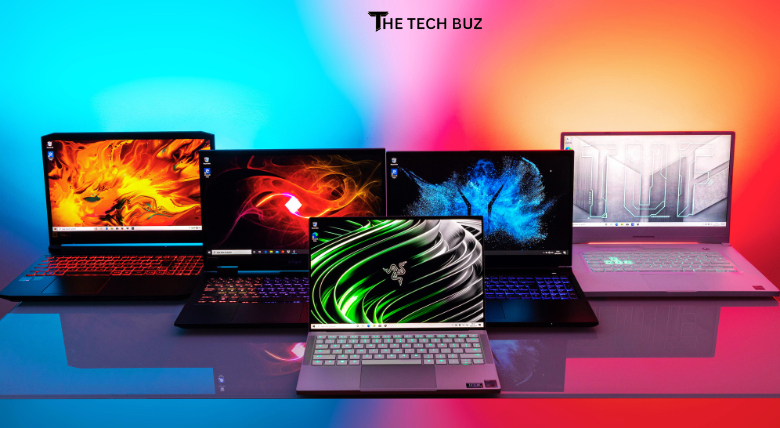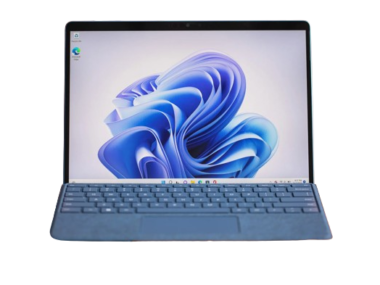Introduction Of Laptop
A laptop computer or notebook computer, also known as a laptop or notebook, is a small, portable personal computer (PC). Laptops typically have a clamshell form factor with a flat-panel screen inside the upper lid and an alphanumeric keyboard and pointing device inside the lower lid. Most of the computer’s internal hardware is fitted inside the lower lid enclosure under the keyboard, although many modern laptops have a built-in webcam at the top of the screen.

History Of Laptops
Alan Kay holding the mockup of his Dynabook concept in 2008
The history of the laptop follows closely behind the development of the personal computer itself. A “personal, portable information manipulator” was imagined by Alan Kay at Xerox PARC in 1968, and described in his 1972 paper as the “Dynabook“. The IBM Special Computer APL Machine Portable (SCAMP) was demonstrated in 1973. This prototype was based on the IBM PALM processor. The IBM 5100, the first commercially available portable computer, appeared in September 1975 and was based on the SCAMP prototype.
IBM 5100 (1975)
As 8-bit CPU machines became widely accepted, portables increased rapidly. The first “laptop-sized notebook computer” was the Epson HX-20, invented (patented) by Suwa Seikosha‘s Yukio Yokozawa in July 1980, introduced at the COMDEX computer show in Las Vegas by Japanese company Seiko Epson in 1981,
Etymology
The terms laptop and notebook both trace their origins to the early 1980s. They were coined to describe portable computers in a size class smaller than the contemporary mainstream units (so-called “luggables”) but larger than pocket computers. The etymologist William Safire traced the origin of the laptop to some time before 1984; the earliest attestation of the laptop found by the Oxford English Dictionary dates to 1983.
Types of laptops
Compaq Armada laptop from the late 1990s
Apple MacBook Air, an “ultraportable” laptop weighing under 3.0 lb (1.36 kg)
Lenovo‘s IdeaPad laptop
Lenovo’s ThinkPad business laptop, originally an IBM product
Asus Transformer Pad, a hybrid tablet, powered by Android OS
Microsoft Surface Pro 3, 2-in-1 detachable
An Alienware gaming laptop with a backlit keyboard and touchpadchpadng Sens laptop
Panasonic Toughbook CF-M34, a rugged laptop/subnotebook
Since the 1970s introduction of portable computers, their forms have changed significantly, spawning a variety of visually and technologically differing subclasses. Excepting distinct legal trademark-around terms (notably Ultrabook), hard distinctions between these classes were rare, and their usage has varied over time and between sources. Since the late 2010s, more specific terms have become less commonly used, with sizes distinguished largely by the size of the screen.

Smaller and larger laptops
Main articles: Notebook form factor, Subnotebook, and Desktop replacement computer
There were in the past several marketing categories for smaller and larger laptop computers; these included “notebook” and “subnotebook” models, low-cost “netbooks“, and “ultra-mobile PCs” where the size class overlapped with devices like smartphones and handheld tablets,
Convertible, hybrid, 2-in-1
The latest trend of technological convergence in the portable computer industry spawned a broad range of devices, which combined features of several previously separate device types. The hybrids, convertibles, and 2-in-1s emerged as crossover devices, which share traits of both tablets and laptops. All such devices have a touchscreen display designed to allow users to work in tablet mode, using either multi-touch gestures or a stylus/digital pen.
Rugged laptop
Main article: Rugged computer
A rugged laptop is designed to reliably operate in harsh usage conditions such as strong vibrations, extreme temperatures, and wet or dusty environments. Rugged laptops are bulkier, heavier, and much more expensive than regular laptops, and thus are seldom seen in regular consumer use.
Hardware
Inner view of a MacBook (Retina) laptop
A SODIMM memory module
The basic components of laptops function identically to their desktop counterparts. Traditionally they were miniaturized and adapted to mobile use, The design restrictions on power, size, and cooling of laptops limit the maximum performance of laptop parts compared to that of desktop components, although that difference has increasingly narrowed.
Display
The typical laptop has a screen that, when unfolded, is upright to the user.
Screen technology
Laptop screens most commonly employ liquid-crystal display (LCD) technology, although the use of OLED panels has risen substantially since 2020.[citation needed] The display interfaces with the motherboard using the Low-voltage differential signaling (LVDS) or embedded DisplayPort protocol.
Surface finish
Externally, it can be a glossy or a matte (anti-glare) screen.
Sizes
In the past, there was a broader range of marketing terms (both formal and informal) to distinguish between different sizes of laptops. These included Netbooks, subnotebooks, Ultra-mobile PCs, and Desktop replacement computers; these are sometimes still used informally, although they are essentially dead in terms of manufacturer marketing.
Resolution
Having a higher resolution display allows more items to fit onscreen at a time, improving the user’s ability to multitask, although, at the higher resolutions on smaller screens, the resolution may only serve to display sharper graphics and text rather than increasing the usable area. Since the introduction of the MacBook Pro with Retina display in 2012,
Central processing unit (CPU)
A laptop’s CPU has advanced power-saving features and produces less heat than one intended purely for desktop use. Mainstream laptop CPUs made after 2018 have at least two processor cores, often four cores, and sometimes more, with 6 and 8 cores becoming more common.
Graphics processing unit (GPU)
On most laptops, the GPU is integrated into the CPU to conserve power and space. This was introduced by Intel with the Core i-series of mobile processors in 2010, followed by similar AMD APU processors in January 2011.
Memory
Since around the year 2000, most laptops have used SO-DIMM slots in which RAM is mounted,[47] although, as of 2021, an increasing number of models use memory soldered to the motherboard, either alongside SO-DIMM slots or without any slots and soldering all memory to the motherboard. Before 2000, most laptops used proprietary memory modules if their memory was upgradable.
Internal storage
The earliest laptops most often used floppy disk for storage, although a few used either RAM disk or tape, by the late 1980s hard disk drives had become the standard form of storage.
Between 1990 and 2009, almost all laptops typically had a hard disk drive (HDD) for storage; since then, solid-state drives (SSD).
Removable media drive
Optical disc drives capable of playing CD-ROMs, compact discs (CD), DVDs, and in some cases, Blu-ray discs (BD), were nearly universal on full-sized models between the mid-1990s and the early 2010s. As of 2021, drives are uncommon in compact or premium laptops; they remain available in some bulkier models, but the trend towards thinner and lighter machines is gradually eliminating these drives and players – when needed they can be connected via USB instead.
Inputs
Closeup of a touchpad on an Acer laptop, where buttons and the touch-sensitive surface are shared
Closeup of a TrackPoint cursor and UltraNav buttons on a ThinkPad laptop
Interfaces on a ThinkPad laptop (2011): Ethernet network port (center), VGA (left), DisplayPort (top right), and USB 2.0 (bottom right). Due to the trend towards very flat laptops and the widespread use of WLAN, the relatively high Ethernet socket is no longer mandatory in today’s devices, as is the technically outdated VGA.
An alphanumeric keyboard is used to enter text, data, and other commands (e.g., function keys). A touchpad (also called a trackpad), a pointing stick, or both, are used to control the position of the cursor on the screen, and an integrated keyboard is used for typing. Some touchpads have buttons separate from the touch surface, while others share the surface.
Expansion cards
In the past, a PC Card (formerly PCMCIA) or ExpressCard slot for expansion was often present on laptops to allow adding and removing functionality, even when the laptop is powered on; these have become increasingly rare since the introduction of USB 3.0. Some internal subsystems such as Ethernet, Wi-Fi, or a wireless cellular modem can be implemented as replaceable internal expansion cards, usually accessible under an access cover on the bottom of the laptop.
Battery and power supply
Main article: Smart battery
Almost all laptops use smart batteries.
Since the late 1990s, laptops have typically used lithium-ion or lithium polymer batteries, These replaced the older nickel metal-hydride typically used in the 1990s, and nickel-cadmium batteries used were in most of the earliest laptops. A few of the oldest laptops used non-rechargeable batteries, or lead–acid batteries.
Power connectors
Laptop power supply with cylindrical coaxial DC power connector
Historically, DC connectors, typically cylindrical/barrel-shaped coaxial power connectors have been used in laptops. Some vendors such as Lenovo made intermittent use of a rectangular connector.
Obsolete
A modem PCMCIA card on a 1990s ThinkPad. The card would normally be fully inserted into the socket.
Features that certain early models of laptops used to have that are not available in most current laptops include:
- Reset (“cold restart”) button in a hole (needed a thin metal tool to press)
- Instant power off button in a hole (needed a thin metal tool to press)
- Integrated charger or power adapter inside the laptop
- Dedicated Media buttons (Internet, Volume, Play, Pause, Next, Previous)
- Floppy disk drive
- Serial port
- Parallel port
- Modem
- IEEE 1394 port
- Docking port
- Shared PS/2 input device port
- IrDA
- S-video port
- S/PDIF audio port
- PC Card / PCMCIA slot
- ExpressCard slot
- CD/DVD Drives (starting with 2013 models)
- VGA port (starting with 2013 models)
Advantages
A teacher using the laptop as part of a workshop for school children
A man using a laptop on a park bench
- Portability is usually the first feature mentioned in any comparison of laptops versus desktop PCs. Physical portability allows a laptop to be used in many places—not only at home and the office but also during commuting and flights, in coffee shops, in lecture halls and libraries, at clients’ locations, or in a meeting room, etc.
- Productivity: Using a laptop in places where a desktop PC cannot be used can help employees and students increase their productivity on work or school tasks, such as an office worker reading their work e-mails during an hour-long commute by train
- Up-to-date information: Using a single laptop prevents fragmentation of files across multiple PCs as the files exist in a single location and are always up-to-date.
- Connectivity: A key advantage of laptops is that they almost always have integrated connectivity features such as Wi-Fi and Bluetooth, and sometimes connection to cellular networks either through native integration or the use of a hotspot. Wi-Fi networks and laptop programs are especially widespread at university campuses.
Other advantages of laptops:
Size
: Laptops are smaller than desktop PCs. This is beneficial when space is at a premium, for example in small apartments and student dorms. When not in use, a laptop can be closed and put away in a desk drawer.
- Low power consumption
: Laptops are several times more power-efficient than desktops. A typical laptop uses 10–100 W, compared to 200–800W for desktops. This could be particularly beneficial for large businesses, which run hundreds of personal computers thus economies of scale - Quiet
: Laptops are typically much quieter than desktops, due both to the components (often silent solid-state drives replacing hard drives) and to less heat production leading to the use of fewer, sometimes no cooling fans. The latter has given rise to laptops that have no moving parts, resulting in complete silence during use. - Battery
: a charged laptop can continue to be used in case of a power outage and is not affected by short power interruptions and blackouts, an issue that is present with desktop PCs. - All-in-One
: designed to be portable, most modern laptops have all components integrated into the chassis. For desktops (excluding all-in-ones) this is usually divided into the desktop “tower” (the unit with the CPU, hard drive, power supply, etc.), keyboard, mouse, display screen, and optional peripherals such as speakers.

Disadvantages
Compared to desktop PCs, laptops have disadvantages in the following areas:
Performance
The majority of laptops released in 2022 are capable of common tasks such as web browsing, video playback, and office applications, even at the low end. That said, the performance of desktops often surpasses comparably priced. The upper limits of performance of laptops remain lower than desktops. Due to mostly practical reasons, such as decreased battery life, increased size and heat, etc.
Upgradeability
The upgradeability of laptops is very limited compared to thoroughly standardized desktops, due to technical and economic reasons. In general, hard drives and memory can be upgraded easily. Due to the integrated nature of laptops, however, the motherboard, CPU, and graphics, are seldom officially upgradeable. Some efforts toward industry-standard parts and layouts have been attempted.






